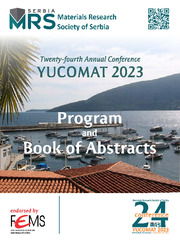| dc.creator | Mihajlović, Dragana R. | |
| dc.creator | Rakin, Marko P. | |
| dc.creator | Bajat, Jelena B. | |
| dc.creator | Međo, Bojan I. | |
| dc.creator | Đokić, Veljko R. | |
| dc.date.accessioned | 2023-12-14T12:24:35Z | |
| dc.date.available | 2023-12-14T12:24:35Z | |
| dc.date.issued | 2023 | |
| dc.identifier.isbn | 978-86-919111-8-8 | |
| dc.identifier.uri | http://TechnoRep.tmf.bg.ac.rs/handle/123456789/6974 | |
| dc.description.abstract | Titanium-based nanotubelayer was formed through the electrochemical anodization technique on
coarse-grained and ultrafine-grained Ti-13Nb-13Zr (wt.%) alloy, in 1M H3PO4 + NaF electrolyte
for 90 minutes. The nanotube layer morphology was analyzed using the scanning electron
microscopy (SEM) and the X-ray diffraction (XRD). The electrochemical impedance spectroscopy (EIS) technique was used to determine the corrosion resistance of the alloy before and after
electrochemical anodization. These materials were exposed to a solution simulating conditions in
the human body (Ringer'
s solution) with pH of 5.5 at a temperature of 37 ºC. In order to investigate
the titanium-based nanotube layer adhesion on alloy surface a scratch test was done. The scratch
test was performedon nanoindenter G200, Agilent Technologies, using an indenter Berkovichtype diamond tip with applying an increasing load up to 40 mN. It was established that electrochemical anodization led to the formation of the nanotube oxide layer on the surface of titaniumbased materials. Influence of the ultrafine-grained material structure on the homogeneity of the
nanotube layer obtained by electrochemical anodization has been noticed. Both coarse-grained
and ultrafine-grained alloy showed excellent corrosion resistance in Ringer’s solution. Moreover,
electrochemical anodization led to a decrease or an increase of the corrosion resistance of these
materials, depending on the nanotube layer morphology. The scratch test showed that plastic
deformation was present in the nanotube layer. The scratch resistance for the nanotube layer
failure was on the higher load, pointing to the good adhesion for the titanium-based nanotube layer
formed using electrochemical anodization. | sr |
| dc.language.iso | en | sr |
| dc.publisher | Belgrade : Materials Research Society of Serbia | sr |
| dc.relation | info:eu-repo/grantAgreement/MESTD/inst-2020/200135/RS// | sr |
| dc.rights | openAccess | sr |
| dc.rights.uri | https://creativecommons.org/licenses/by/4.0/ | |
| dc.source | Programme and The Book of Abstracts / Twenty-fourth Annual Conference YUCOMAT 2023, Herceg Novi, Montenegro, September 4 - 8, 2023 | sr |
| dc.title | Corrosion and scratch resistance of the nanotube layer formed on the titanium-based materials | sr |
| dc.type | conferenceObject | sr |
| dc.rights.license | BY | sr |
| dc.citation.spage | 171 | |
| dc.identifier.fulltext | http://TechnoRep.tmf.bg.ac.rs/bitstream/id/19068/Corrosion_and_scratch_pub_2023.pdf | |
| dc.identifier.rcub | https://hdl.handle.net/21.15107/rcub_technorep_6974 | |
| dc.type.version | publishedVersion | sr |

